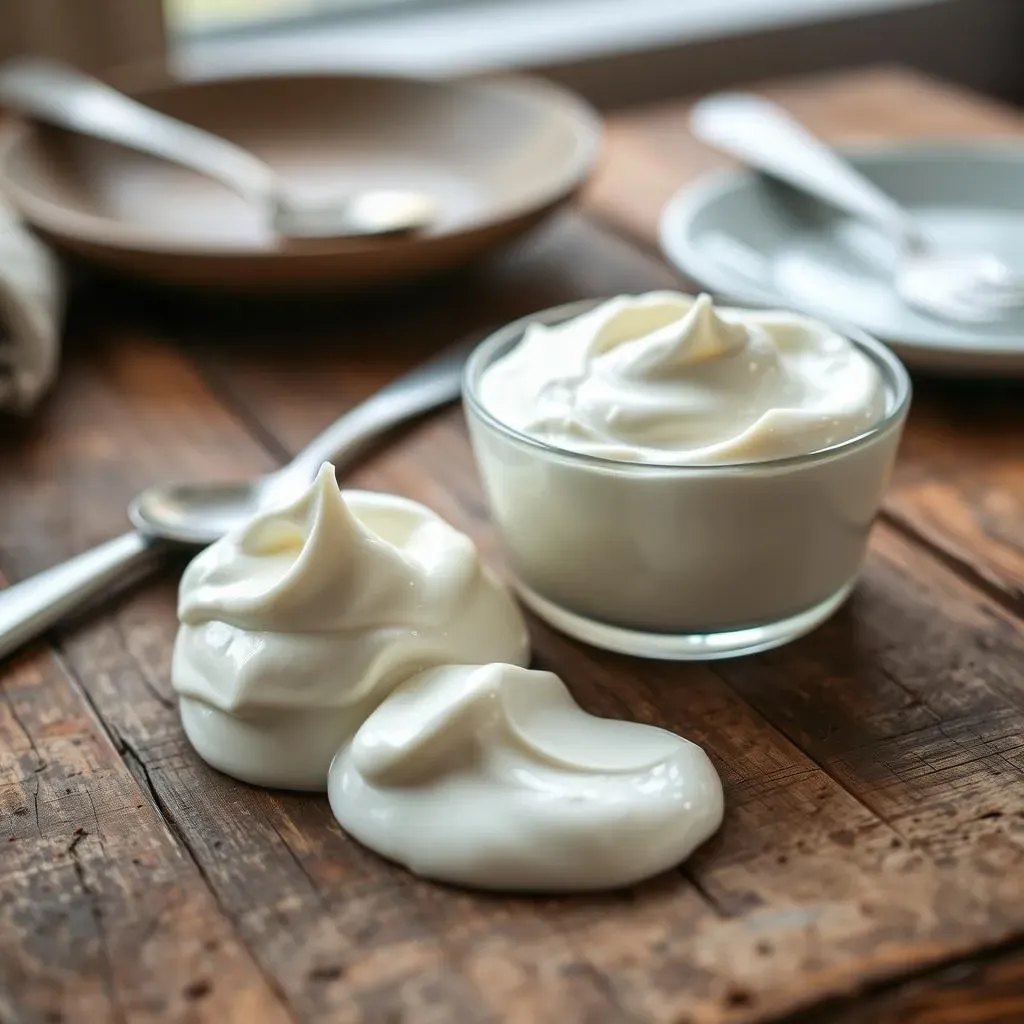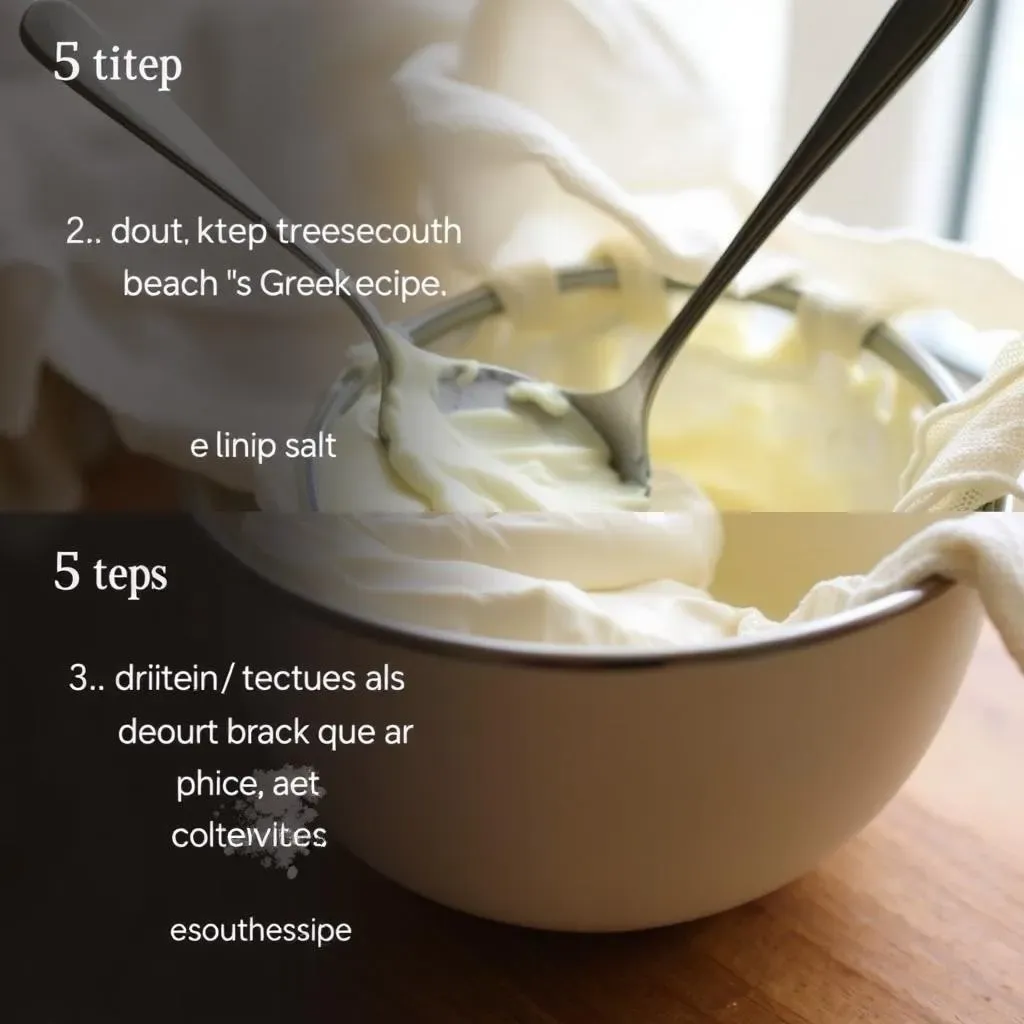Table of Contents
Ever found yourself staring into the fridge, recipe in hand, only to realize you're out of Greek yogurt? Or maybe you've got a tub of sour cream and a craving for something tangy. The question then pops up: is sour cream a good substitute for greek yogurt? It's a common kitchen conundrum, and honestly, the answer isn't a simple yes or no. They're both creamy, both tangy, but they've got their own personalities. In this article, we'll break down the key differences between these two dairy delights. We'll explore their flavors, textures, and how they behave in cooking and baking. We will also look at when a swap will work and when it might not be the best idea. By the end, you'll be a pro at deciding when sour cream can step in for Greek yogurt and when it's best to stick with the original. Let's get started!
Understanding the Basics: Sour Cream and Greek Yogurt

Understanding the Basics: Sour Cream and Greek Yogurt
What is Sour Cream?
Let's start with sour cream. It's made by fermenting regular cream with lactic acid bacteria. This process is what gives it that signature tangy flavor and thick texture. Think of it like milk's rebellious cousin – it's got that richness, but with a bit of a punch. It's not as thick as you might think; it's more of a smooth, dollopy kind of consistency. You often find it as a topping for tacos or baked potatoes, adding a cool, creamy counterpoint to savory dishes.
What is Greek Yogurt?
Now, let's talk about Greek yogurt. It also starts with milk, but it goes through a straining process that removes a lot of the whey (the liquid part). This makes it much thicker and creamier than regular yogurt. It's got a similar tang to sour cream, but it's a little brighter and more pronounced. You can see how it's often hailed as a healthy option because of its high protein content and lower fat (depending on the type you buy). It's a favorite for breakfasts, smoothies, and even as a base for dips and sauces.
Characteristic | Sour Cream | Greek Yogurt |
|---|---|---|
Base Ingredient | Cream | Milk |
Texture | Smooth, dollopy | Thick, creamy |
Tanginess | Mild | More pronounced |
Protein Content | Lower | Higher |
Key Differences at a Glance
So, while both sour cream and Greek yogurt are dairy products with a tangy profile, they differ quite a bit. Sour cream is richer and has a higher fat content, while Greek yogurt is thicker, tangier, and packed with protein. The way they're made and their nutritional profiles lead to differences in how they behave in recipes. This is why it's important to understand their characteristics before deciding if you can swap one for the other. It's like comparing a sports car to a truck – both are vehicles, but they're built for different things.
Flavor and Texture: How They Compare

Flavor and Texture: How They Compare
The Tang Factor
Okay, let's talk about the taste. Sour cream has a mild tang, it's like a gentle nudge on your taste buds. It's there, but it doesn't shout. Think of it as a smooth, slightly tart note that balances out richness. On the other hand, Greek yogurt brings a brighter, more pronounced tang to the party. It's more of a zing, like a playful spark that wakes up your mouth. If you’re looking for that extra bit of sharpness, Greek yogurt is your go-to. It’s the difference between a soft whisper and a clear, confident statement.
Creaminess and Consistency
Now for the feel. Sour cream is smooth and dollopy, it’s got a velvety texture that coats your tongue. It’s like a soft blanket. It's not super thick, so it tends to blend easily into dishes. Greek yogurt, though, is a whole different story. It's super thick, almost like a dense cloud. It’s got a spoon-standing kind of consistency, and it holds its shape really well. This difference in texture is key when you're thinking about substituting one for the other. One is like a silky scarf, and the other is like a firm, plush cushion.
Characteristic | Sour Cream | Greek Yogurt |
|---|---|---|
Tanginess | Mild, gentle | Bright, pronounced |
Texture | Smooth, dollopy | Thick, dense |
How These Differences Impact Your Cooking
So, why does all of this matter? Well, that mild tang of sour cream means it won't overpower other flavors, making it great for creamy sauces and dips where you want a subtle tartness. The thickness of Greek yogurt, however, means it can add a lot of body to dishes, and its stronger tang can cut through richness. Imagine using sour cream in a delicate lemon sauce – it would add a lovely creaminess without stealing the show. Now picture Greek yogurt in a spicy curry; that extra tang would help to balance the heat and bring some brightness. It’s all about how these differences play out in your dish, and what you're hoping to achieve with your cooking.
Is Sour Cream a Good Substitute for Greek Yogurt? Practical Applications

Is Sour Cream a Good Substitute for Greek Yogurt? Practical Applications
When the Swap Works Wonders
Okay, so you're in the kitchen, recipe in hand, and you’ve realized you're out of Greek yogurt but have a tub of sour cream. Don't panic! In many cases, sour cream can actually be a pretty decent substitute. Especially in situations where you're looking for creaminess and a touch of tang. Think of things like dips, creamy sauces, or even as a topping for things like chili or tacos. Sour cream will give you that lovely richness and will blend smoothly without creating a huge shift in flavor. It's not a perfect swap all the time, but it's a great option in a pinch. Just be mindful of the texture and the slight difference in tang.
When It's Best to Be Cautious
Now, let's talk about the times when swapping sour cream for Greek yogurt might not be the best idea. If you're baking, especially when the recipe depends on the thickness and protein of Greek yogurt, you might find that sour cream just doesn't cut it. For example, if you're making a cake or muffins that rely on the structure of Greek yogurt, sour cream could make your bake a bit too wet and dense. Also, if you're using it in a recipe where the tang of Greek yogurt is a key element, like a marinade or a dressing, sour cream might not give you the same zing. So, you've got to think about the role the dairy is playing in the recipe, before you make the swap. It's about understanding what the recipe needs.
Real-Life Examples and Considerations
Let’s look at some practical examples, shall we? If you are making a creamy pasta sauce, sour cream can totally work as a stand-in for Greek yogurt. It'll add richness and a nice tang. However, if you're trying to make a healthier smoothie that relies on the protein of Greek yogurt, sour cream won't give you the same nutritional boost. Also, consider the fat content. Sour cream is higher in fat, so if you're trying to reduce fat, Greek yogurt is the better choice. It really all boils down to what you’re trying to achieve and what aspect of either product is most important for the recipe you’re making. It’s like choosing the right tool for the job – you wouldn't use a hammer to screw in a screw, would you?
Scenario | Good Substitute? | Why/Why Not? |
|---|---|---|
Creamy Pasta Sauce | Yes | Adds richness and tang |
Baking (cakes, muffins) | Use with caution | May make it too wet/dense |
Healthy Smoothie | No | Lower protein, higher fat |
Dips | Yes | Blends smoothly, good for creamy consistency |
Marinades | Use with caution | Milder tang might not be enough |
Making the Swap: Tips and Tricks for Success

Making the Swap: Tips and Tricks for Success
Adjusting for Texture
Okay, so you're going for it, you're swapping sour cream for Greek yogurt. The first thing to think about is the texture. Sour cream is smoother and more fluid, while Greek yogurt is much thicker. If your recipe calls for that super thick texture of Greek yogurt, you can try to thicken your sour cream. One easy way is to drain it. Place the sour cream in a cheesecloth-lined sieve and let it sit in the fridge for a couple of hours. This will remove some of the excess liquid, making it a bit denser. Another trick is to add a little bit of cornstarch. Start with a small amount, like a teaspoon per cup, and mix it in well to avoid clumps. This can help you achieve a consistency that's closer to Greek yogurt. It’s like trying to make a silk scarf feel more like a plush pillow – it takes a little bit of work, but it can be done.
Taming the Tang
Next up, let’s talk about the tang. Greek yogurt has a more pronounced tartness than sour cream. If you're using sour cream and want to boost that zing, there are a few things you can do. Try adding a squeeze of lemon juice or a dash of vinegar. Start with a small amount and taste as you go, you can always add more. Another option is to add a pinch of salt. Salt enhances flavors, and it can help to bring out the tartness in the sour cream. It's all about tweaking things until you get the flavor you're looking for. It’s like tuning a musical instrument – you want to get that perfect note.
Trick | How to Do It | Why It Works |
|---|---|---|
Drain Sour Cream | Place in cheesecloth-lined sieve in fridge for hours | Removes excess liquid, thickens |
Add Cornstarch | Mix small amount (1 tsp per cup) in | Thickens the mixture |
Lemon Juice/Vinegar | Add a squeeze/dash, taste as you go | Boosts the tang |
Pinch of Salt | Add a small amount, taste as you go | Enhances the flavor and tang |
Taste as You Go
The golden rule when substituting ingredients is to taste, taste, taste! Don't just dump in the sour cream and hope for the best. Start by adding a little bit, taste, and then adjust as needed. This way, you can make sure that the flavors and texture are just right for your recipe. It's like being a detective in the kitchen – you're looking for the perfect balance. Also, if possible, do a small test batch before you commit to the full recipe. This will give you a chance to see how the swap works and make any necessary adjustments. It’s better to be safe than sorry, right? Cooking is an adventure, and sometimes, the best discoveries are made when you're willing to experiment and tweak things along the way.